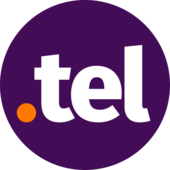
Back .tel AST .tel Byelorussian .tel BE-X-OLD .tel Catalan .tel CE .tel Czech .tel Danish .tel German .tel DIQ .tel EML
 | |
| Introduced | 2005 |
|---|---|
| TLD type | Sponsored top-level domain |
| Status | Approved |
| Registry | Telnames Limited |
| Sponsor | Telnames Limited |
| Intended use | Contact Details |
| Registration restrictions | None |
| Structure | Direct second-level registrations are permitted; single digits and single-numeric domains are restricted |
| Documents | ICANN New sTLD RFP Application, Policies |
| Dispute policies | UDRP, Sunrise dispute resolution procedure[1] |
| Registry website | Telnames |

The domain name .tel is a top-level domain (TLD) in the Domain Name System (DNS) of the Internet. It was approved by ICANN as a sponsored top-level domain, and is operated by Telnic.[2] Telnic announced in January 2011 that over 300,000 domains had been registered since the start of general availability on 24 March 2009. A substantial drop of mostly IDN .tel's occurred at the beginning of 2014. The total number of registered websites under .tel as of 9 October 2023 is approximately 43,227.[3]
The domain's purpose is to provide a single name space for Internet communications services. Subdomain registrations serve as a single point of contact for individuals and businesses, providing a global contact directory service by hosting all types of contact information directly in the Domain Name System, without the need to build, host or manage a traditional web service. Additionally, as of July 2010, every .tel domain acts as an OpenID and an increasing number of Voice over Internet Protocol (VoIP) clients can address a .tel domain name directly.[4] The TLD implementation also supports the hCard micro-format.[5]
- ^ "Telnic | FAQ". Telnic.org. Archived from the original on 6 January 2009. Retrieved 6 January 2009.
- ^ "Telnic web site". Telnic.org. Archived from the original on 2 March 2001. Retrieved 29 February 2012.
- ^ "Domain Count Statistics for TLDs". DomainTools. Archived from the original on 8 February 2014. Retrieved 9 October 2023.
- ^ "voipGATE show off new .tel-powered apps at UCExpo « Telnic's Blog". Telnic.org. 11 March 2010. Archived from the original on 21 March 2012. Retrieved 29 February 2012.
- ^ "Telnic increases .tel data portabilitywith hCard, OAuth and OpenID" (PDF). Archived from the original (PDF) on 9 April 2011. Retrieved 10 March 2011.
© MMXXIII Rich X Search. We shall prevail. All rights reserved. Rich X Search